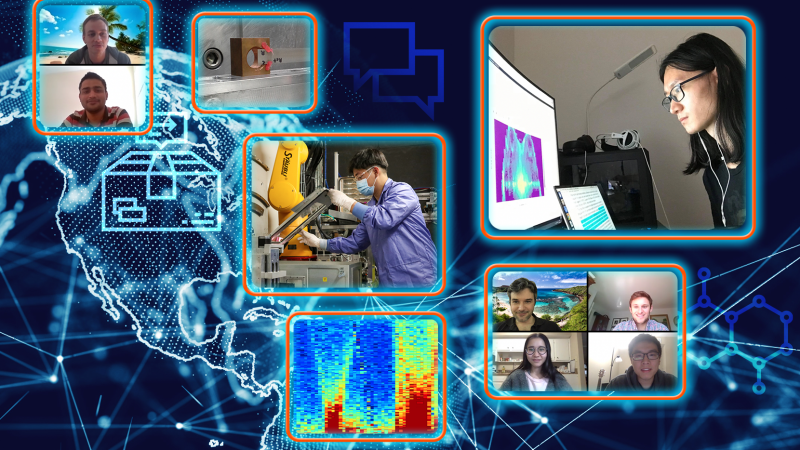How can scientists conduct experiments if they can’t be in the same room with their samples and instruments? That was the challenge the Department of Energy’s (DOE’s) Oak Ridge National Laboratory (ORNL) faced when the COVID-19 pandemic began to unfold.
“The High Flux Isotope Reactor (HFIR) and the Spallation Neutron Source (SNS) were two of the few neutron sources in the world that didn’t shut down completely as a result of the pandemic. At first, these facilities were utilized for research related to the COVID-19 pandemic. We then gradually opened our operating instruments to run other experiments.” said ORNL Neutron Scattering Division Director Hans Christen.
The HFIR and the SNS at ORNL, two of the most powerful neutron sources in the world, attract hundreds of researchers to the laboratory each year to utilize the facilities’ cutting-edge, world-class technology.
However, as the number of COVID-19 cases began to rise globally, ORNL set restrictions on campus visits to minimize the risk of transmission and maintain the ability to support critical missions. Although external researchers still cannot physically enter the laboratory at this time, ORNL’s temporary remote access experiment program continues to enable scientists to use the neutron sources without setting foot on campus.
The program allows researchers with approved proposals to send their samples to the laboratory and provide remote, real-time direction as internal instrument scientists perform neutron scattering experiments on their behalf.
Neutrons are deeply penetrating and nondestructive particles, making them a powerful tool for probing different materials and gathering insight on their atomic structure and behavior. ORNL’s neutron facilities offer a suite of instruments that harness these unique properties for both fundamental and applied research.
“We wanted to do something to make sure that science didn’t come to a complete standstill. There are researchers that may need results to write their next grant or finish up a publication, and some students may need just a few more measurements to complete their dissertations,” said Crystal Schrof, manager of the ORNL Neutron Sciences Directorate’s Scientific and Program Services Office. “We came up with a system where instrument scientists could essentially run experiments for users where possible during this time period.”
ORNL staff review all proposals and select promising experiments that have the potential to be completed through remote participation. Since late April, 201 scientists from 78 institutions have taken advantage of this program to advance their research.
In total, 179 remote access experiments have been performed at HFIR and SNS. These projects have involved several of ORNL’s neutron scattering instruments and cover a wide range of scientific fields including physics, chemistry, biology, energy sciences, and engineering.
Throughout the entire experiment process, remote participants and ORNL instrument scientists stay in contact by telephone and videoconferencing while ORNL’s remote computing resources allow researchers to view their data as it’s acquired by the instrument. These communication efforts enable both parties to make experiment preparations, analyze the collected data, discuss next steps, and make changes to the experiments where needed.
“The role of the instrument scientist in general is to help the visiting researchers run their experiments as efficiently as possible and help them with data analysis. With the remote access experiment program, we are trying to facilitate this active collaboration without the user being physically present,” said ORNL instrument scientist Matthias Frontzek. “Some remote access experiments require more work or need to be adapted, but I'm amazed to see that there is only a limited number of experiments that are not possible through this system.”
“The staff have been very creative in developing this new approach. I think it is a real testament to their dedication to the scientific community,” said Schrof.
“These facilities are essential for a lot of science to continue. It’s quite rewarding to be able to go to the laboratory and help researchers collect the data they need,” said ORNL instrument scientist Jeffrey Bunn.
ORNL is accepting new proposals for remote access experiments at HFIR and SNS until noon (ET), September 16, 2020. Because of experiment carryover and COVID-19 research, the Magnetism Reflectometer, Liquids Reflectometer, and Bio-SANS instruments will not be available in this proposal call.
While the remote access experiment program is temporary, neutron sciences staff at ORNL are exploring long-term remote options that researchers could employ in the future. This includes potentially increasing the number of instruments that accept mail-in experiments and developing remote experiment capabilities at the laboratory, where scientists could steer instruments by remote control.
“This pandemic has presented many new challenges for the science community, but I think it is quite critical that we still press on with our scientific investigations,” said Olivier Delaire, an associate professor of mechanical engineering and materials science at Duke University who has participated in the remote access experiment program. “We are thankful that these facilities are still running and that there is an avenue to advance our scientific programs safely.”
COVID-19 research at ORNL is supported in part by the DOE Office of Science through the National Virtual Biotechnology Laboratory, a consortium of DOE national laboratories focused on response to COVID-19, with funding provided by the Coronavirus CARES Act.
HFIR and SNS are DOE Office of Science User Facilities. ORNL is managed by UT-Battelle LLC for DOE’s Office of Science, the single largest supporter of basic research in the physical sciences in the United States. DOE’s Office of Science is working to address some of the most pressing challenges of our time. For more information, visit https://energy.gov/science. —by Olivia Trani








